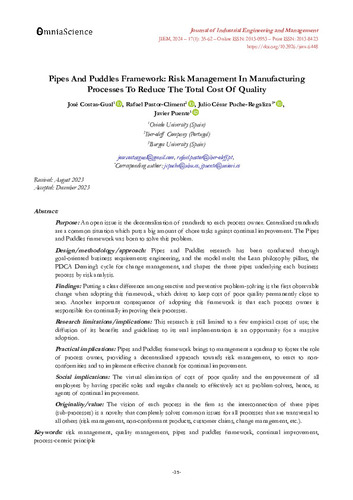Pipes and puddles framework: risk management in manufacturing processes to reduce the total cost of quality
Autor(es) y otros:
Fecha de publicación:
Versión del editor:
Citación:
Descripción física:
Resumen:
Purpose: Decentralize standards to each process owner is an open issue. Centralized standards are a common situation which puts a big amount of chore tasks against continual improvement. The pipes and puddles framework was born to solve this problem. Design/methodology/approach: Pipes and puddles framework takes its ground in risk management, which is carried out from the perspective of the physics of the process. Findings: Putting a clear difference among reactive and preventive problem-solving is the first observable change when adopting this framework, which drives to keep cost of poor quality (COPQ) permanently close to zero. Another important consequence of adopting this framework is that there is no person responsible for the continuous improvement process, but each process owner is responsible for the continuous improvement of their process. Research limitations/implications: This research is still limited to a few empirical cases of use; the diffusion of its benefits and guidelines to its real implementation is an opportunity for a massive adoption. A formal representation is also necessary. Practical implications: Pipes and puddles framework brings to management a roadmap to foster the role of process owner, providing a decentralized approach towards risk management, to react to non-conformities and to implement effective channels for continual improvement. Social implications: Approach to a green factory as a direct consequence of elimination of COPQ and the empowerment of all employees by having specific roles and regular channels to effectively act as agents of continual improvement. Originality/value: The vision of each process in the firm as the interconnection of three pipes (sub-processes) is a novelty that completely solves common issues for all processes that are transversal to all others (risk management, non-conformant products, customer claims, change management, etc.).
Purpose: Decentralize standards to each process owner is an open issue. Centralized standards are a common situation which puts a big amount of chore tasks against continual improvement. The pipes and puddles framework was born to solve this problem. Design/methodology/approach: Pipes and puddles framework takes its ground in risk management, which is carried out from the perspective of the physics of the process. Findings: Putting a clear difference among reactive and preventive problem-solving is the first observable change when adopting this framework, which drives to keep cost of poor quality (COPQ) permanently close to zero. Another important consequence of adopting this framework is that there is no person responsible for the continuous improvement process, but each process owner is responsible for the continuous improvement of their process. Research limitations/implications: This research is still limited to a few empirical cases of use; the diffusion of its benefits and guidelines to its real implementation is an opportunity for a massive adoption. A formal representation is also necessary. Practical implications: Pipes and puddles framework brings to management a roadmap to foster the role of process owner, providing a decentralized approach towards risk management, to react to non-conformities and to implement effective channels for continual improvement. Social implications: Approach to a green factory as a direct consequence of elimination of COPQ and the empowerment of all employees by having specific roles and regular channels to effectively act as agents of continual improvement. Originality/value: The vision of each process in the firm as the interconnection of three pipes (sub-processes) is a novelty that completely solves common issues for all processes that are transversal to all others (risk management, non-conformant products, customer claims, change management, etc.).
ISSN:
DOI:
Patrocinado por:
This work was financially supported by State Research Agency (Ministry of Science and Innovation of theGovernment of Spain) via the projects “SPeeding Up the transition towards Resilient circular economynetworks: forecasting, inventory and production control, reverse logistics and supply chain dynamics”(MCIN/AEI/10.13039/501100011033) (SPUR, grant ref. PID2020-117021GB-I00), and “Methodologies forsolving problems with economic, social and environmental criteria. Application to healthcare resourcemanagement” (FEDER Funds – Knowledge Generation Projects) (ECOSOEN-HEALTH, grant ref. PID2022-139543OB-C44). The authors deeply appreciate the financial support received.
Colecciones
- Administración de Empresas [514]
- Artículos [37541]
- Investigaciones y Documentos OpenAIRE [8415]
Ficheros en el ítem





